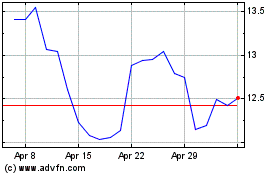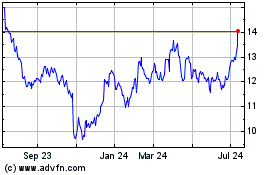By Nora Naughton
LAS VEGAS -- Auto dealers want to lure young buyers back to
new-car lots.
Auto makers have in recent years turned away from cheaper
models, such as hatchbacks and small sedans, to focus their lineups
on the higher-priced SUVs and trucks that have surged in popularity
with the drop in fuel prices.
The shift has helped lift new-vehicle prices to record levels
and boost profitability for the auto sector.
But dealers, gathering at a conference in Las Vegas this past
weekend, warned that the trend is also pricing many buyers out of
the new-car market.
The main casualty, they said, are younger adults. "We really do
need the younger buyers in these new vehicles," said Charlie
Gilchrist, the 2019 chairman of the National Automobile Dealers
Association, in an interview.
Used-car shoppers typically aren't loyal to one brand, and auto
retailers count on drawing first-time buyers to build repeat
business, he said.
"That first vehicle they have is an impression that they will
keep the rest of their lives," said Mr. Gilchrist, who is also a
dealer in Texas.
The number of new vehicles purchased by buyers between the ages
of 16 and 35 fell nearly 4.5% last year, according to J.D. Power.
That is a more dramatic decrease than the overall U.S. market saw
in 2019.
By comparison, purchases by customers older than 56 increased
nearly 1% in 2019, J.D. Power found.
"The financial challenges that young consumers face are
multifaceted and well-documented," said Tyson Jominy, vice
president of data and analytics for J.D. Power, referring to high
student-loan and rent payments already plaguing young consumers.
"But we can't discount the role that higher monthly new car
payments and insurance play on lower sales."
He also cited the availability of ride hailing as a factor
delaying the purchase of a car for some young people.
U.S. auto sales are cooling, down roughly 1% last year, after
more than a half-decade of growth and hitting a record of 17.5
million in 2015. In that time, new-vehicle prices have steadily
increased, in part because of the industry's shift to larger, more
expensive vehicles, but also owing to more advanced technology and
safety features and rising material prices, dealers and analysts
said.
The average price paid for a new vehicle last year was $33,600,
up $1,100 from 2018, according to J.D. Power. Prices are expected
to keep rising this year, supported by expensive tech features and
bolstered by steady demand, dealers and analysts said. Auto
executives and industry experts are forecasting new vehicle sales
of just under 17 million this year, which is still considered a
healthy level.
To make vehicles more affordable, car companies are spending
more on discounts while many lenders are stretching out repayment
terms. Dealers said interest rates, while a concern in years past,
have come back down again, giving customers some cost relief this
year.
Fiat Chrysler Automobiles NV's head of U.S. sales, Reid Bigland,
who met with dealers in Las Vegas over the weekend, said he doesn't
see higher car prices affecting demand this year.
"It's always a concern, affordability, but it doesn't seem to be
showing its face," Mr. Bigland said.
Still, the average monthly payment for a new vehicle was $566
last year, about $150 more than the average payment of a used
vehicle, according to Cox Automotive. Analysts expect used-car
sales to hit a record this year.
Cheaper sedans and hatchbacks have traditionally served as the
affordable option for first-time car buyers. Companies such as
Toyota Motor Corp. and Nissan Motor Co. have said they are sticking
with these models, even as demand has dropped off significantly, in
part to preserve that gateway into the brand.
The U.S. auto makers have taken a different tack. Ford Motor Co.
no longer sells in the U.S. the Focus and Fiesta, two small-car
models that have long served as a more affordable option for
budget-minded buyers, to plow more resources into expanding its SUV
lineup. General Motors Co. has stopped building the Chevy Cruze.
Fiat Chrysler turned away from the sedan market in 2016, dropping
the compact Dodge Dart and scaling back its Chrysler sedan
offerings.
That has left fewer options for buyers on a budget. Sales of
cars priced at $20,000 or less plummeted 20% last year, according
to J.D. Power, while sales of more expensive cars -- going for more
than $40,000 -- increased 7%.
The migration to used vehicles for younger buyers is unavoidable
as sticker prices on new cars keep rising, said Mike Maroone, a
former president of AutoNation Inc. who owns dealerships in
Colorado and Florida. But he is taking the change in stride, he
said, leveraging new-car discounts when he can while looking for
ways to build loyalty among used-car buyers.
"A lot of customers come in with a payment in mind, not a
product," Mr. Maroone said. "Affordability is a big issue, so we
need to be building up our used-car business."
(END) Dow Jones Newswires
February 18, 2020 08:14 ET (13:14 GMT)
Copyright (c) 2020 Dow Jones & Company, Inc.
Ford Motor (NYSE:F)
Historical Stock Chart
From Mar 2024 to Apr 2024

Ford Motor (NYSE:F)
Historical Stock Chart
From Apr 2023 to Apr 2024
